 |
||
Cruising the Canaux du Centre, France
-
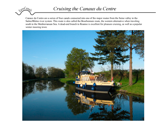
-

-

-
 The first stop after leaving the Seine at St Mammes is this pleasant halte at Moret-sur-Loing.
The first stop after leaving the Seine at St Mammes is this pleasant halte at Moret-sur-Loing.
-
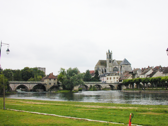 Moret-sur-Loing has numerous points of interest to attract visitors; the town also offers special events,including heritage and music festivals, wine, cheese,crafts and antiques fairs, as well as a sound-and-light show.
Moret-sur-Loing has numerous points of interest to attract visitors; the town also offers special events,including heritage and music festivals, wine, cheese,crafts and antiques fairs, as well as a sound-and-light show.
-
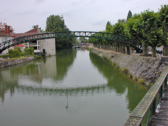 At Montargis, the largest city on the Loing/Briare route, the canal passes directly through the middle of the city, making for interesting sights at locks and passerelles (footbridges) over the canal.
At Montargis, the largest city on the Loing/Briare route, the canal passes directly through the middle of the city, making for interesting sights at locks and passerelles (footbridges) over the canal.
-
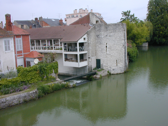 Many small non-navigablecanals cross the city, thus it has been called the "Venice of Burgundy".
Many small non-navigablecanals cross the city, thus it has been called the "Venice of Burgundy".
-
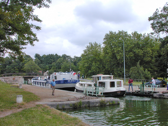 A converted fuel barge takes up most of the lock, but still enough room for a Locaboat penichette.
A converted fuel barge takes up most of the lock, but still enough room for a Locaboat penichette.
-
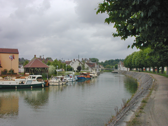 The port at Chatillon-Coligny offers access to several good restaurants in the old quarter, along the narrow streets, and a market on Friday mornings.
The port at Chatillon-Coligny offers access to several good restaurants in the old quarter, along the narrow streets, and a market on Friday mornings.
-
 The modern docks and a capitainerie with full facilities make this a comfortable mooring.
The modern docks and a capitainerie with full facilities make this a comfortable mooring.
-
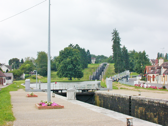 Rogny-les-Sept-Écluses is a popular stop, to see the historic seven locks.
Rogny-les-Sept-Écluses is a popular stop, to see the historic seven locks.
-
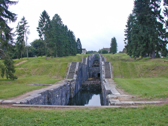 This ladder of locks was a remarkable feat of engineering when built during the reign of Henry IV.
This ladder of locks was a remarkable feat of engineering when built during the reign of Henry IV.
-
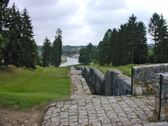 It has now been replaced by a more efficient chain of six non-contiguous locks.
It has now been replaced by a more efficient chain of six non-contiguous locks.
-
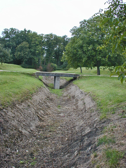 The old canal route over the summit now disappears into the trees.
The old canal route over the summit now disappears into the trees.
-
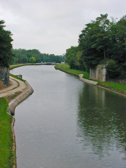 The descent from the summit on the Canal de Briare curves through dense woods.
The descent from the summit on the Canal de Briare curves through dense woods.
-
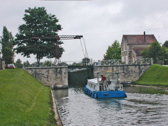 Locks on this section of the Canal de Briare are automatic and are grouped in chains, controlled by a remote lockkeeper.
Locks on this section of the Canal de Briare are automatic and are grouped in chains, controlled by a remote lockkeeper.
-
 Some locks on the climb up to the summit from Briare past Ouzouer-sur-Trézée include very old lifting bridges.
Some locks on the climb up to the summit from Briare past Ouzouer-sur-Trézée include very old lifting bridges.
-
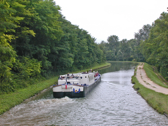 Hotel barges travel the Canal de Briare; this is "Le Bon Vivant".
Hotel barges travel the Canal de Briare; this is "Le Bon Vivant".
-
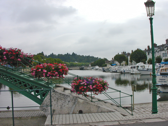 The Port de Plaisance at Briare is at the old junction, now unused, of the canal with the river Loire.
The Port de Plaisance at Briare is at the old junction, now unused, of the canal with the river Loire.
-
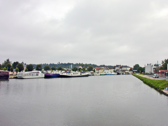 The Port de Commerce at Briare is the northern end of the Canal lateral a la Loire.
The Port de Commerce at Briare is the northern end of the Canal lateral a la Loire.
-
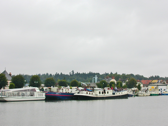 This is a busy port, home base for hotel barges and rental boats, as well as day-tour boats.
This is a busy port, home base for hotel barges and rental boats, as well as day-tour boats.
-
 Just west of the port is the canal bridge over the river Loire.
Just west of the port is the canal bridge over the river Loire.
-
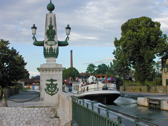 The beautiful columns marking the four corners of the bridge were designed by Eiffel, of Eiffel Tower fame.
The beautiful columns marking the four corners of the bridge were designed by Eiffel, of Eiffel Tower fame.
-
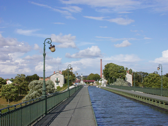 Looking back toward Briare from the middle of the bridge.
Looking back toward Briare from the middle of the bridge.
-
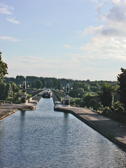 Hotel barges cruise the bridge at sunset on summer evenings, a spectacular sight from onboard or from the land.
Hotel barges cruise the bridge at sunset on summer evenings, a spectacular sight from onboard or from the land.
-
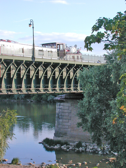 The water level in the canal bridge is about 8 meters higher than the river.
The water level in the canal bridge is about 8 meters higher than the river.
-
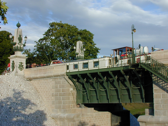 The bridge is of iron construction on masonry piers.
The bridge is of iron construction on masonry piers.
-
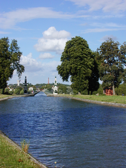 The canal at the western end of the bridge provides space for waiting boats.
The canal at the western end of the bridge provides space for waiting boats.
-
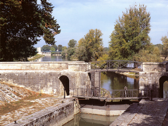 Les Mantelots lock has recently been restored, to allow the local riverboats (with very shallow draft) to leave the river in winter and shelter in the large basin above the lock.
Les Mantelots lock has recently been restored, to allow the local riverboats (with very shallow draft) to leave the river in winter and shelter in the large basin above the lock.
-
 A feeder canal brings water to fill the locks.
A feeder canal brings water to fill the locks.
-
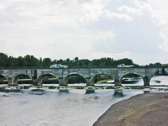 The canal crosses the Allier River on the second of the impressive canal bridges along the Loire, the 343-meter Le Guétin bridge.
The canal crosses the Allier River on the second of the impressive canal bridges along the Loire, the 343-meter Le Guétin bridge.
-
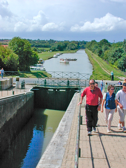 The view to the north, from the bridge. Now the grass field at left has been developed into a park and a mooring quay.
The view to the north, from the bridge. Now the grass field at left has been developed into a park and a mooring quay.
-
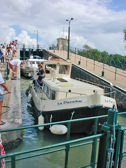 Two northbound boats have crossed the bridge and have descended through the bridge-level lock into this lower lock.
Two northbound boats have crossed the bridge and have descended through the bridge-level lock into this lower lock.
-
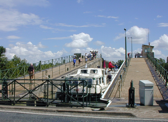 The northbound boats have now been replaced in the lower lock by three southbound boats; these boats will soon move ahead.
The northbound boats have now been replaced in the lower lock by three southbound boats; these boats will soon move ahead.
-
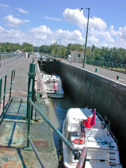 The boats are entering the bridge-level lock. The lock is over 38 meters long and can accomodate three 10-12 meter boats.
The boats are entering the bridge-level lock. The lock is over 38 meters long and can accomodate three 10-12 meter boats.
-
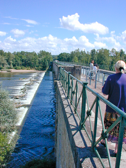 The walkway along the west side of this lock provides a view of the river passing over a weir.
The walkway along the west side of this lock provides a view of the river passing over a weir.
-
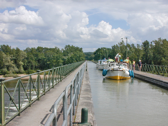 A northbound group of three boats awaits the signal to enter the lock.
A northbound group of three boats awaits the signal to enter the lock.
-
 Le Guetin locks are No. 21 & 22; on the north theLaubray lock is 5.611 kilometers ahead. On the south, the Jaugenay lock is 20.664 kilometers away. The Verville branch canal (to Nevers) is at 10.125 km distance.
Le Guetin locks are No. 21 & 22; on the north theLaubray lock is 5.611 kilometers ahead. On the south, the Jaugenay lock is 20.664 kilometers away. The Verville branch canal (to Nevers) is at 10.125 km distance.
-
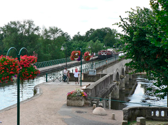 As the canal enters Digoin it crosses the third and shortest (200 meters), but still imposing, canal bridge over the Loire, a stone structure of eleven arches.
As the canal enters Digoin it crosses the third and shortest (200 meters), but still imposing, canal bridge over the Loire, a stone structure of eleven arches.
-
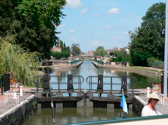 The Canal latéral à la Loire ends at Digoin but the southbound route continues on the Canal du Centre.
The Canal latéral à la Loire ends at Digoin but the southbound route continues on the Canal du Centre.
-
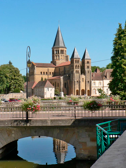 Paray-le-Monial, the first town beyond Digoin, is an important pilgrimage destination for Christians.
Paray-le-Monial, the first town beyond Digoin, is an important pilgrimage destination for Christians.
-
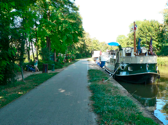 There are several very nice haltes; for those interested in exploring the vineyards and wine shops, the most popular is at Santenay.
There are several very nice haltes; for those interested in exploring the vineyards and wine shops, the most popular is at Santenay.
-
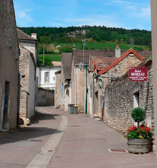 Santenay is divided into upper and lower sections. This is Bas, or lower, Santenay.
Santenay is divided into upper and lower sections. This is Bas, or lower, Santenay.
-
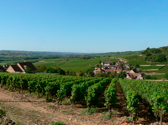 The village is surrounded by hills and vineyards.
The village is surrounded by hills and vineyards.
-
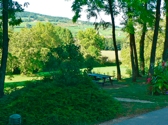 The view from the Santenay halte is one of the most beautiful in France.
The view from the Santenay halte is one of the most beautiful in France.
-
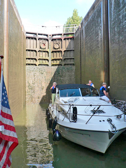 A motorboat completing the exciting passage through the 11-meter lock #34b, at Crissey.
A motorboat completing the exciting passage through the 11-meter lock #34b, at Crissey.
-
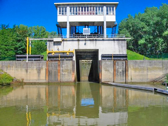 Northbound, the view approaching the lock can be a bit daunting.
Northbound, the view approaching the lock can be a bit daunting.
-
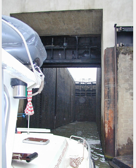 The structure might seem to be a giant mechanical compactor which would grind up the boat and its passengers.
The structure might seem to be a giant mechanical compactor which would grind up the boat and its passengers.
-
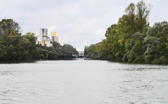 The Saône river is just over one kilometer below the lock.
The Saône river is just over one kilometer below the lock.